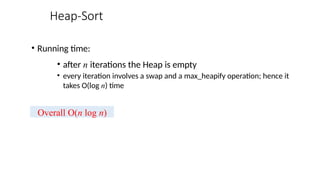Heap Sort sorting algorithm analysis of algorithm.pptx
- 1. Menu • Priority Queues • Heaps • Heapsort
- 2. Priority Queue A data structure implementing a set S of elements, each associated with a key, supporting the following operations: increase_key(S, x, k) : insert element x into set S return element of S with largest key return element of S with largest key and remove it from S increase the value of element x’ s key to new value k (assumed to be as large as current value) insert(S, x) : max(S) : extract_max(S) :
- 3. Heap • Implementation of a priority queue • An array, visualized as a nearly complete binary tree •Max Heap Property: The key of a node is≥ than the keys of its children (Min Heap defined analogously) 161410 8 7 9 3 2 4 1 1 2 3 4 5 6 7 8 9 10 10 8 9 2 4 1 16 1 2 14 3 4 5 7 6 7 3 8 9 10
- 4. Heap as a Tree root of tree. :first element in the array, corresponding to i = 1 parent(i) =i/2: returns index of node's parent left(i)=2i. : returns index of node's left child right(i)=2i+1: returns index of node's right child 10 8 9 16 1 2 14 161410 8 7 9 3 2 4 1 1 2 3 4 5 6 7 8 9 10 3 4 5 7 6 7 3 8 9 10 2 4 1
- 5. Heap Operations insert, extract_max, heapsort produce a max-heap from an unordered array correct a single violation of the heap property in a subtree at its root build_max_heap : max_heapify :
- 9. Max_Heapify Pseudocode Max_Heapify(A,i): l = left(i) r = right(i) if (l <= heap-size(A) and A[l] > A[i]) then largest = l else largest = i if (r <= heap-size(A) and A[r] > A[largest]) then largest = r if largest != i then exchange A[i] and A[largest] Max_Heapify(A, largest)
- 10. Build_Max_Heap(A) • Converts A[1…n] to a max heap • Build_Max_Heap(A): • heap-size(A) = length(A) for i=n/2 downto 1 do Max_Heapify(A, i) • Why start at n/2? • Because elements A[n/2 + 1 … n] are all leaves of the tree 2i > n, for i > n/2 + 1 Time= O(n log n) via simple analysis
- 13. Build-Max-Heap
- 14. Heap-Sort Sorting Strategy: 1. Build Max Heap from unordered array; 2. Find maximum element A[1]; 3. Swap elements A[n] and A[1]: now max element is at the end of the array! 4. Discard node n from heap (by decrementing heap-size variable) 5.New root may violate max heap property, but its children are max heaps. Run max_heapify to fix this. 6. Go to Step 2 unless heap is empty.
- 15. Heap-Sort Demo Swap A[10] and A[1] Max_heapify(A,1)
- 16. Heap-Sort Demo Swap A[9] and A[1]
- 17. Heap-Sort Demo
- 18. Heap-Sort Demo Swap A[8] and A[1]
- 19. Heap-Sort • Running time: • after n iterations the Heap is empty • every iteration involves a swap and a max_heapify operation; hence it takes O(log n) time Overall O(n log n)

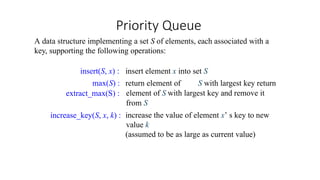

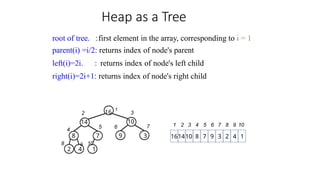
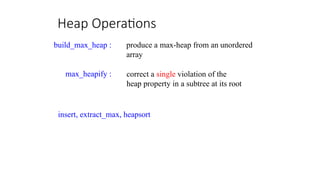



![Max_Heapify Pseudocode
Max_Heapify(A,i):
l = left(i)
r = right(i)
if (l <= heap-size(A) and A[l] > A[i])
then largest = l
else largest = i
if (r <= heap-size(A) and A[r] > A[largest])
then largest = r
if largest != i
then exchange A[i] and A[largest]
Max_Heapify(A, largest)](https://image.slidesharecdn.com/heapsort-250412055337-f28169db/85/Heap-Sort-sorting-algorithm-analysis-of-algorithm-pptx-9-320.jpg)
![Build_Max_Heap(A)
• Converts A[1…n] to a max heap
• Build_Max_Heap(A):
• heap-size(A) = length(A)
for i=n/2 downto 1
do Max_Heapify(A, i)
• Why start at n/2?
• Because elements A[n/2 + 1 … n] are all leaves of the tree 2i > n, for i > n/2 +
1
Time= O(n log n) via simple analysis](https://image.slidesharecdn.com/heapsort-250412055337-f28169db/85/Heap-Sort-sorting-algorithm-analysis-of-algorithm-pptx-10-320.jpg)
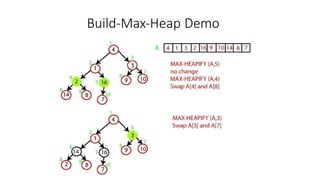


![Heap-Sort
Sorting Strategy:
1. Build Max Heap from unordered array;
2. Find maximum element A[1];
3. Swap elements A[n] and A[1]:
now max element is at the end of the array!
4. Discard node n from heap
(by decrementing heap-size variable)
5.New root may violate max heap property, but its children are max
heaps. Run max_heapify to fix this.
6. Go to Step 2 unless heap is empty.](https://image.slidesharecdn.com/heapsort-250412055337-f28169db/85/Heap-Sort-sorting-algorithm-analysis-of-algorithm-pptx-14-320.jpg)
![Heap-Sort Demo
Swap A[10] and
A[1]
Max_heapify(A,1)](https://image.slidesharecdn.com/heapsort-250412055337-f28169db/85/Heap-Sort-sorting-algorithm-analysis-of-algorithm-pptx-15-320.jpg)
![Heap-Sort Demo
Swap A[9] and
A[1]](https://image.slidesharecdn.com/heapsort-250412055337-f28169db/85/Heap-Sort-sorting-algorithm-analysis-of-algorithm-pptx-16-320.jpg)
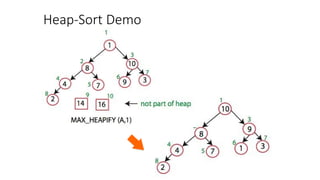
![Heap-Sort Demo
Swap A[8] and
A[1]](https://image.slidesharecdn.com/heapsort-250412055337-f28169db/85/Heap-Sort-sorting-algorithm-analysis-of-algorithm-pptx-18-320.jpg)
